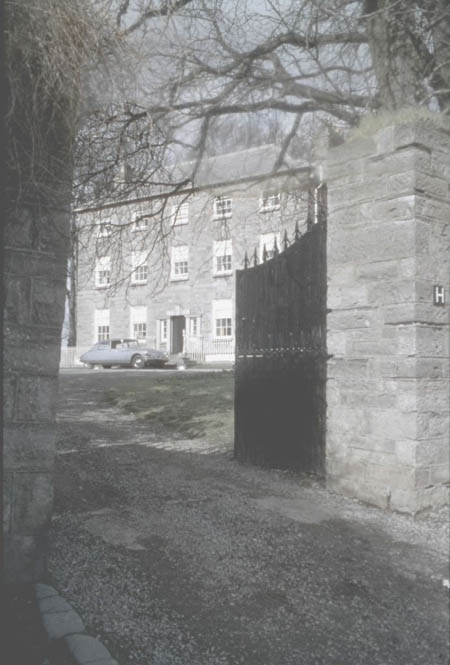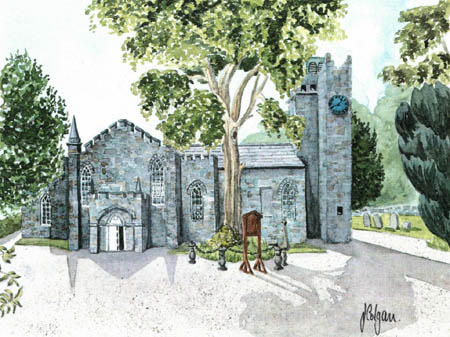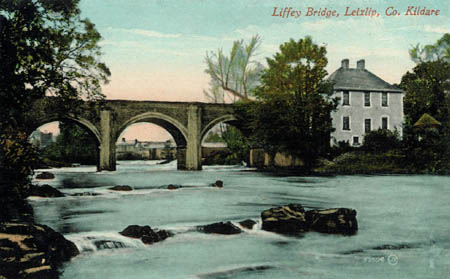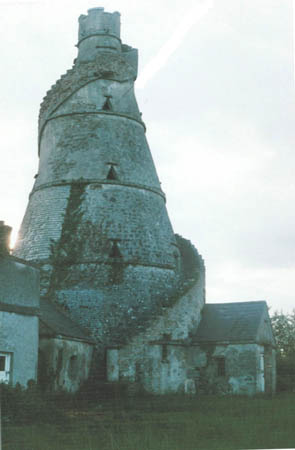Leixlip was traversed by the Liffey, running west to east on the southside of the town, as it is today. However, the river was much narrower where the reservoir created in the 1940s is and the pair of large waterfalls called the Salmon Leap that gave the town its name was visible.
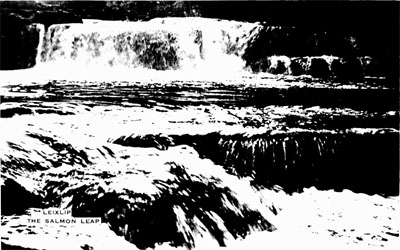 Salmon Leap Falls
Salmon Leap Falls
A turret or gazebo stood in Cooldrinagh lands overlooking the river and the place of a broken bridge, only one arch of which remained.
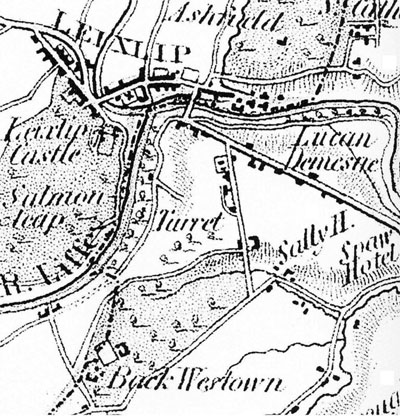 Cooldrinagh 1837, recording Turret
Cooldrinagh 1837, recording Turret
The Rye Water took the same general course to the north of the town and tumbled down to join the Liffey; its bed was nearer the land surface; it subdivided into several fingers in the Newtown area before descending to the confluence with the Liffey near the existing Boat House in Leixlip demesne.
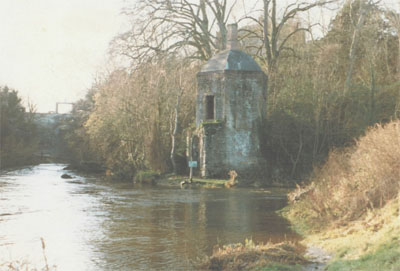 Leixlip Castle Boat House
Leixlip Castle Boat House
A road from Ryevale House, then called Robertsville, after the first owner, Robert Lawe, Barrackmaster General of Ireland, crossed the Rye at what is now called Distillery Lane and a ‘Manufactory’ there, driven by water power, provided employment for men, women, and children as young as nine years in processing calico. Lawe, too, owned this.
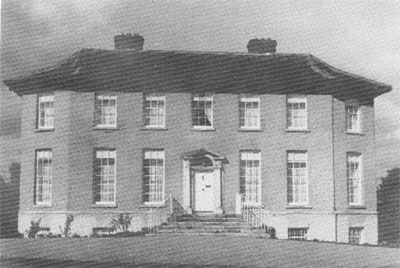 Ryevale House, Leixlip
Ryevale House, Leixlip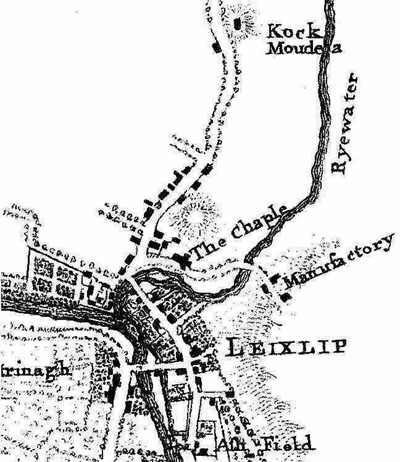 Printing Manufactory, Ryevale, ~1760
Printing Manufactory, Ryevale, ~1760
James Smyth, a calico printer there, was a leading rebel in 1798. This road continued east towards St Catherine’s Park en route for Dublin on the north bank of the Liffey. The Boat House was not the folly it is today. The Rye Water was also divided to encircle the Island Farm to the rear of James Glascock’s Music Hall and residence, the remains of which continued until the Industrial Development Authority’s acquisition of Collinstown in the 1970s. Downstream of Distillery Lane and just up from the bridge over the Rye on Main Street, was another water-powered and ancient corn mill, whose workers lived in several small cabins alongside the Rye.
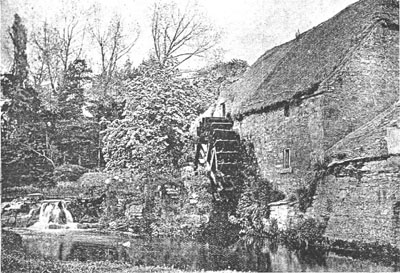
Ennis’s Mill on Rye
Facing Rye Cottage were residences of farmers, James Coogan and John Rowe (aka Roe) and another holding of Christopher Rowe, each under leases from 1794.
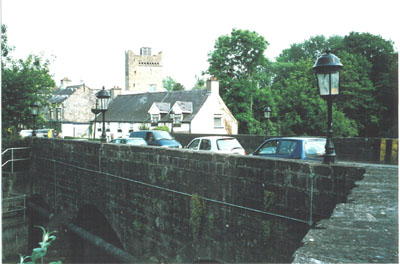
Rye Cottage Main Street
The miller lived in the three-storey, Mill House, currently French Estates, at the east corner of Buckley’s Lane.
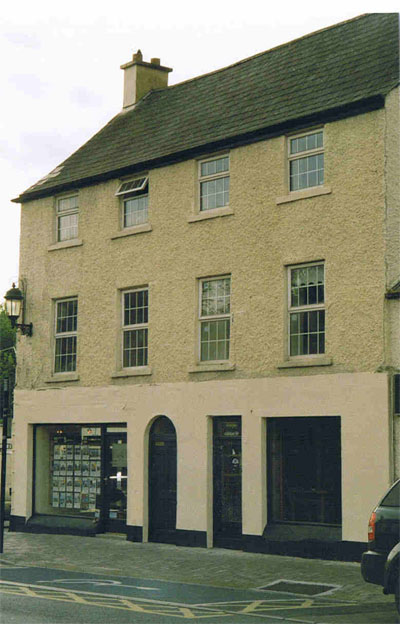 Mill House, Dempsey family home
Mill House, Dempsey family home
Access to the Castle was by way of a road which ran through the burial ground in front of St Mary’s Church, then much as it is today and via a ford over the Rye to the foot of the hill to the front of the Castle.
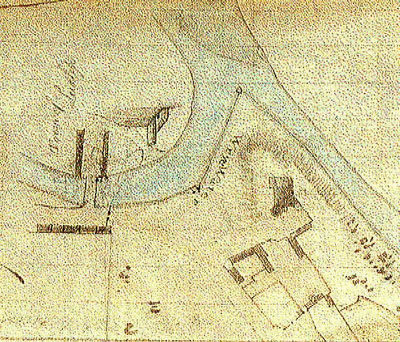 Leixlip Castle map, showing route through Church
Leixlip Castle map, showing route through Church
However in 1783 the business of the town was flourishing prompting Lady Louisa Conolly to have a market house built in the yard in front of St Mary’s Church. The Church’s railings were added later, ~1840. A humped-back bridge crossed the Rye at the end of the Main Street by 1793, quite near the beginning of Buckley’s Lane, then the entrance to Edward Bulkeley’s premises. Water from the Liffey reached up into what is now Maher’s Lane, almost to Main Street level. This was the town’s watering slip, for which slips the government provided encouragement. Horses and carts descended it to fill barrels with water for all purposes. Rye Cottage was as it is today, then in the possession of Mr John Whealon, distiller. There had been a slaughterhouse to the rear. Between Rye Cottage and the Rye Water, and forward to the street, was Eleanor Tankard’s ‘Bridge Tenement’, a very small square-sectioned cabin. It may have been a watch-house. The footprint of what is now Sam’s Chipper was much the same as it is today, complete with setback (20ft 6in deep by 8ft 6in wide) at the entrance to the lane; it was then rented to widow, Jane Herbert, and a ‘bakehouse’ operated there with a yard to rear. The house now known as the Glebe or Yellow House, then called Glynn’s tenement (probably after the builder of the Wonderful Barn), had been used as a residence by military officers attached to units garrisoned in the Castle.
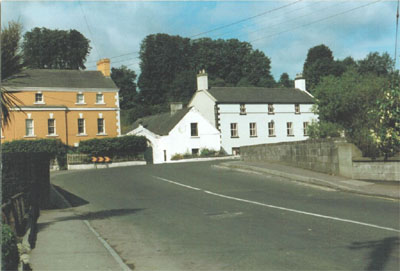 Leixlip Glebe and tavern
Leixlip Glebe and tavern
Sir Richard Steele lived there. Steele was shot and injured at the battle of Ovidstown, near Maynooth, on 19/6/1798. Another military tenant of the place was Captain Douglass (1793) of the Argyle Fencibles. The Castle had been the home of Major General Robert Sandford, known as ‘Captain O’Blunder’, who had beautified the place. He died in 1793. He was long past his army career at this stage. During the turbulent times that immediately followed, he was succeeded by other military leaders, such as Major Brown. In 1808 the demesne lands were surveyed for Major Brown in a letting to Francis Thos Power, a clothing manufacturer. Power probably used what was later to be the parish hall as his factory where he made ladies clothes. Shortly before Sandford’s tenure it was used as a summer residence by Lord Townshend, the Viceroy, who returned to Ireland during the rebellion of 1798 as a soldier. A map made of the Castle for the landlord after Sandford’s death, showed far more buildings than thirty years later. The demesne lands were let to locals: Widow Cassidy, John Dalton, Neal, Murray, Coane, Coogan, etc. Cassidy may have been the widow of a prominent Kildare Loyalist of the Rebellion period. A Michael Dalton held the ‘Swan Holding’; its whereabouts is unknown, but as it was worth over £25 pa, it was substantial. William Bruce, an established Dublin stationer, was leasing the ‘Salmon Leap Holding’, from Tom Conolly, the location indeterminate. A map attached to the lease is puzzling as the land doesn't seem to be near either the Inn or the river, but more in the Cedar Park/ Green Lane/ Station Road area of today.
John Healy lived in a cottage at the junction of Old Hill and Station Road (within the curtilage of the later Hillford House); the Duke of Leinster and other turnpike commissioners met in his house on 5/2/1803 to discuss the compensation which might be payable to occupiers of premises on the route of the proposed new ‘bypass’ of the Old Hill.
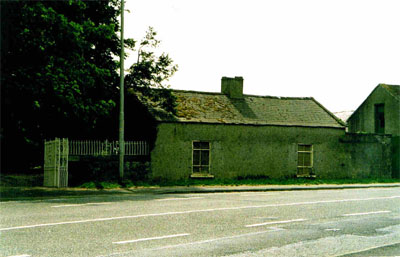 John Healy’s House, Gallivan’s Cross
John Healy’s House, Gallivan’s Cross
Among those affected were Pearce Cassidy, Catherine Hynes, Denis Nowlan, Thomas Doonan, John Dalton, and yeoman, Nicholas Dempsey A jury to assess the damages included Rodio Guinness, Mark Cannon and Thomas Goodshaw, all of Leixlip town; and William Rose, a Yeoman, of Collinstown. St Mary’s Church was the ‘established’ or State church and its vestry had oversight over some civilian matters, including law and order. A ‘Court Leet’, centred on the Castle, dealt with civil disputes. The ‘Papist’ or RC community worshipped in a small chapel hidden away on the banks of the Rye; it also served as a school and probably as a residence for the curate; Andrew Ennis, the parish priest, was shared with Maynooth.
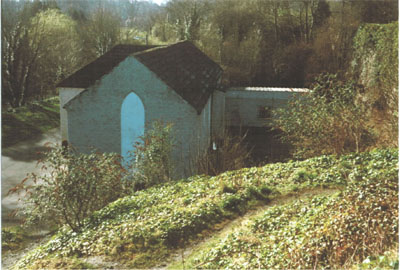 Leixlip Chapel in the Vale
Leixlip Chapel in the Vale
The Dublin to Mullingar turnpike road had been open since 1732 or shortly afterwards. The Main Street at the end of the century was not dissimilar to today’s road. At the east end, Shingled House (then occupied by Charles – brewer - and Anne Fellows, assigns of John Barton, brewer, a branch of whose family established themselves in the wine business in France) and Ivy House (then occupied by George, the earliest of the Fergusson doctors or ‘surgeons’) were about fifty years old. The Toll House on the bridge would have had its porch recently added, with iron-barred windows to the front and a padlocked pair of gates added outside, in recognition of the troubled times there were in it. These bars would have been made by the tenant, Peter Tannam, a blacksmith and farrier. Tannam, despite his occupation leading to a natural, strong suspicion of him as a maker of illicit weapons by the government forces, survived the rebellious period into the 1820s. A local yeoman, Nicholas Dempsey, stood guard by the Toll House porch. Across the bridge, the Salmon Leap Inn, had not long been rebuilt (probably after a fire); landlord, Tom Conolly, required it to be roofed in slates as a condition of the tenancy.
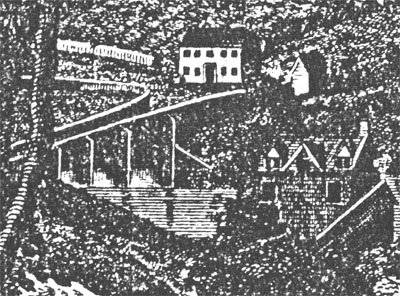
Salmon Leap Inn and Liffey Bridge c1760
The tenant at the turn of the century was ‘George Warner’s representatives’ (indicating that he was dead); however, Richard Guinness may have been the hands-on tenant at the time. Richard had continued working his more famous brother, Arthur Guinness’s first serious brewery, built in the then fashionable courtyard style, on the Main Street until the turn of the century. Water was supplied from wells now beneath the footpaths to the street. The Courtyard Hotel (est. 2005) includes the brewery buildings. Richard Guinness lived in Castle View, a detached house on Main Street, later to be a barracks. He was compensated for losses of hay, cattle etc at Sallins in the Rebellion.
Cooldrinagh Lane was only recently opened up as a road, and the terrace of houses on the east side newly built. The remains of the old road to the New Bridge at Parsonstown on the south side of the Liffey was in place and used by Leixlip workers to go to and from the flax or corn mill on the Liffey, later to be Wookey’s flock mills.
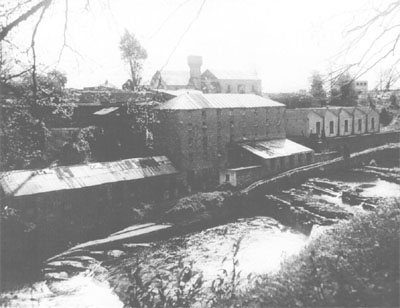 Salmon Leap Flax, later Flock, Mills
Salmon Leap Flax, later Flock, Mills
Charles Croker, an attorney, lived a Croker Lodge, within Backweston Park, through whose lands the road traversed. Over at the corner of Mill Lane and Main Street (now EBS financial services) stood the ‘shoemaker’s tenement’, occupied by Christopher McGowan: it passed to his son, William, a cabinet-maker, in 1805. Also in the vicinity of Mill Lane, including the north side of the street, were tenants John Downes and Widow Barry.
Deep down in Mill lane stood the Leixlip iron works, the only such in Co Kildare. It was run for some years by Daniel Marston (aka Marsden) until his death about 1798 at a comparatively young age. Was his death from natural causes, or a consequence of rebellion? A couple of Marston’s children had died in the preceding few years. He is said to have lived at St Catherine’s Park and was a man of considerable means. He is buried in St Mary’s churchyard; the table stone over his grave is now quite indecipherable. His eldest son, Captain Molyneux Marston, succeeded him. The iron mills made spades, bar iron etc, and would be a prime suspect for the secret making of pike heads and other weapons. During this period iron was sometimes supplied to the landlord, Conolly, of Castletown House, in lieu of rent.
Adjoining it stood the corn mill in the tenancy of John McDaniel. For several decades now, both had shared one mill race, whereas hitherto there had been two. The Black Castle (ca 17c), probably at least a storey taller and with a basement below the current ground-floor, stood guarding the road to Dunboyne, now called Sileachán Lane.
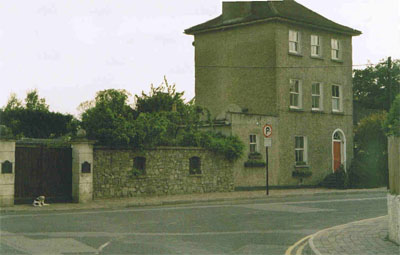 The modernised Black Castle (~17c)
The modernised Black Castle (~17c)
There was a tendency in modern times for the Black Castle to be occupied by one of the millers working nearby. The Beere family, one of whom married a daughter of John Molyneaux (d1736), lived in Leixlip and early in the 19th century in this house. On 14/2/1798, the Irish House of Commons ordered that Daniel Beere, Deputy Pursuivant [= follower, attendant] of the court of the Exchequer, do attend at the Bar of this House forthwith. He was taken into custody, examined at the Bar and then discharged. Oral tradition has it that the Black Castle was occupied in 1798 by the military and a gallows erected outside, perhaps as much for to terrorise the local peasants as for use. On both sides of the Black Castle stood nine or ten two-roomed thatched cottages, one half for the use of iron workers and their families, the other for the corn mill workers.
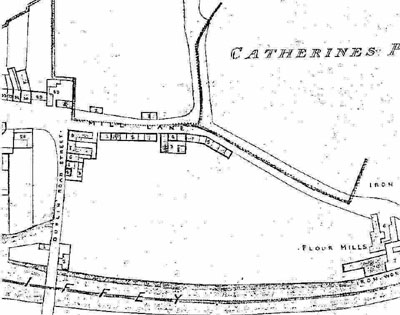 Mill cottages about the Black Castle, c1810
Mill cottages about the Black Castle, c1810
The land behind and in front of the Black Castle was called Ashfield, suggesting a wood of ash trees - just what was needed to make handles for pike weapons as well as innocuous cart wheels. Marshfield House was at the end of Mill Lane. It was occupied by Captain Thomas Atkinson, a military officer, who married Grace Alice Cane, aka Coane, daughter of a local clergyman.
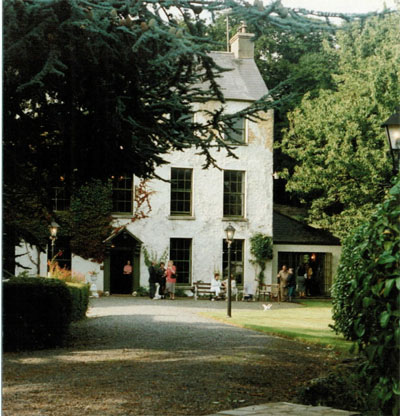 Marshfield House
Marshfield House
The Black Avenue was in place and between it and Mill Lane, within the lands of Marshfield, was a man-made canal linked to the Liffey, and used as a fish store, a kind of refrigerator of the day for the occupiers of Marshfield.
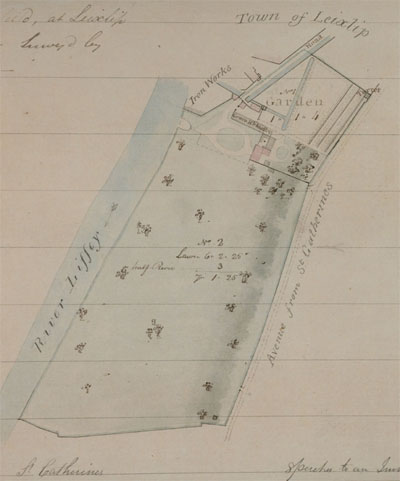 Fish storage at Marshfield, c1816
Fish storage at Marshfield, c1816
The road continued on down to St Catherine’s Park, where a tall house stood, recently tenanted by the Earl of Lanesborough, but in 1792 occupied by David La Touche, of the Huguenot banking family.
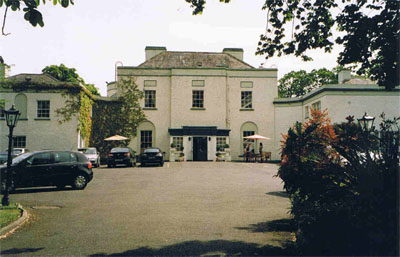 St.Catherine’s Park (post 1792) now Liffey Valley House Hotel
St.Catherine’s Park (post 1792) now Liffey Valley House Hotel
It shortly thereafter burned to the ground and about 1798 a new house, also called St Catherine’s Park, was built in the same townland to the design of Francis Johnston; it is now Liffey Valley House Hotel.
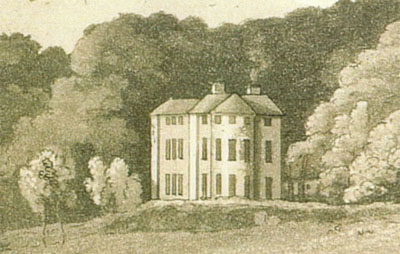
St Catherine's Park c.1792
It was later occupied by a succession of generals in the 19th century. Sentry boxes set against the demesne walls housed soldiers on security duty; they were red coats. Across the Liffey from St Catherine’s Park was Lucan Demesne, the seat of Agmondisham Vesey, Colonel of the Co Dublin Militia.
Sileachán Lane continued up to the Confey Road and onwards past the already ruined Confey Castle; the line of road continued past Confey Stud residence and on to Dunboyne.
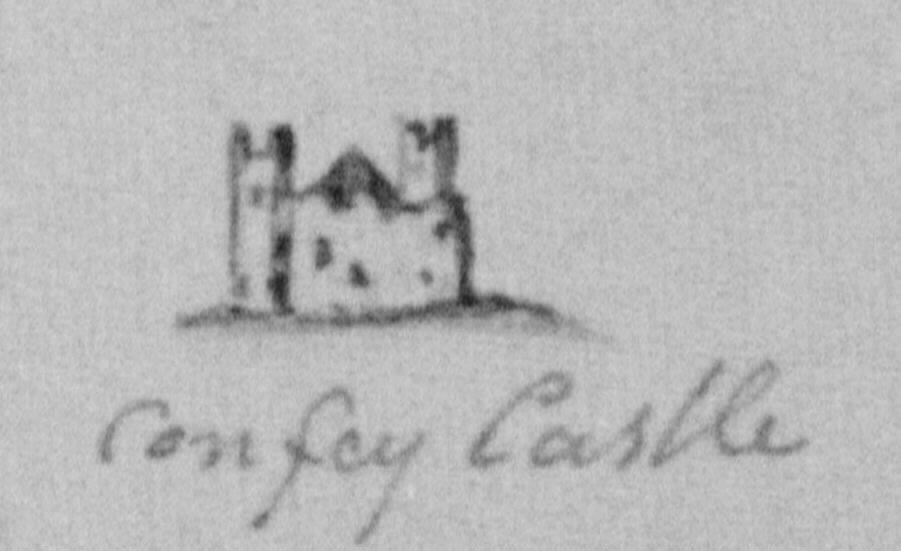 Thumb-nail sketch of Confey Castle ruin ~1800
Thumb-nail sketch of Confey Castle ruin ~1800
On the left near the modern Glendale estate was a large farmhouse, Newtown Park. This was home to the Goodshaw family of farmers and millers; a daughter, Jane, married Richard Turner, the famous maker of wrought iron-framed glass houses.
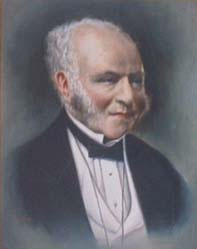 Richard Turner, Ironmaster, of Leixlip
Richard Turner, Ironmaster, of Leixlip
The construction of the Royal Canal made its way across the north side of Leixlip, creating a cul de sac of Sileachán Lane thenceforth. Thousands of labourers and stonemasons worked on the construction of the Canal, particularly on the enormous engineering project of the day, the aqueduct which carried it across the Rye Water. They came from far and near and probably lived in the many small cottages which, fifty years later, were found to be ruined as Millicent man, Richard Griffith’s valuers assessed them for local tax purposes. Some would have dwelt in lodgings in the town and they, more than most, would have created a demand for market produce.
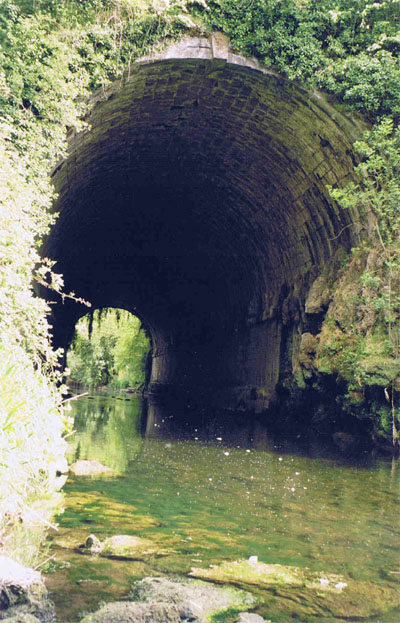 Royal Canal Aqueduct over the Rye at Leixlip
Royal Canal Aqueduct over the Rye at Leixlip
Leixlip House, on the Captain’s Hill, had been built ~45 years earlier as Gazebo Park William Brady, a trustee of the Turnpike, and was still occupied by him and his namesake son. General Brady received the arms of local men in an amnesty during the rebellion of 1798. The General died on 25/5/1800. Slightly further up the hill, a Queen-Anne-style house, Newtown Hill House, had transferred into the ownership of Guinness – probably Richard Guinness, the Leixlip brewer - as the previous owner, Miss Elizabeth Bryan, had commissioned a survey of her property at Newtown in 1796; this was usually done in readiness for a sale or lease.
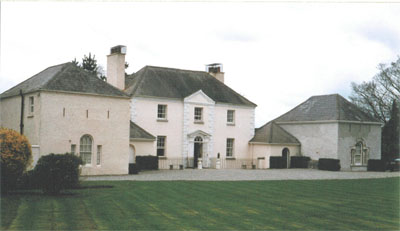
Newtown Hill House
A little further up, Newtown House, was in the control of Hamilton Rowan, the rebel leader, for papers instructing the distribution of arms were found a century later in the attic.
Leixlip’s Main Street was more or less as it appears today: The Mall terrace had been built by a speculative builder called Roecastle ~1785. Recent archaeological examinations within these houses revealed floors of regular, but small cobble stones about 0.8 metres beneath the internal floors in several of the houses, confirming that earlier houses, probably dating back to the Norman period, had been set much further back towards the sharp escarpment to the rear which encloses the town centre. This feature is crudely shown in a map of 1752. The terrace had earlier been called the Parade. ‘The Parade’ is redolent of ‘redcoats’, or kilted, gaelic-speaking Highlander soldiers, promenading themselves about this part of the town as a routine exercise, or whilst accompanying the gentry who dwelt in Leixlip Castle on their state visits, of which newspapers of the day attest.
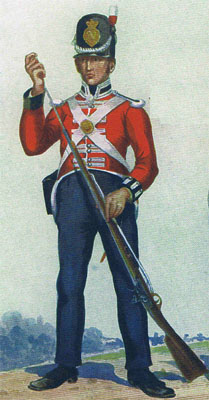 Soldier in typical uniform, c1800
Soldier in typical uniform, c1800
The sites of the Mall houses extended originally down to the river, thus confirming that the houses on the south side of the Main Street were built not long after them, a tradition continued by contemporary developers in analogous situations! The Old Hill was then the main road to Maynooth and the west. During the Rebellion the Duke of Leinster’s daughters had to go that route to collect passes from the Castle; they passed the hanging body of a man called Byrne, bearing green ribbons, on a nearby tree. There were cottages on the west side of Old Hill from Pound Street to the junction with the Celbridge to Barnhall road, which had been built less than fifty years. Between the latter road and Green Lane was a race course in the tenancy of John Keegan, farmer. To its west were the ‘concerns’ of Michael Bartley, Thomas Burke, John and Bart Coogan and to the west, the concerns of Andrew Kelly and Charles Neill (aka Neal). Daniel Simmonds, for around 25 years secretary to the Turnpike Commissioners, lived at Collinstown House.
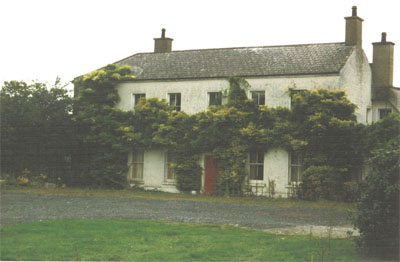 Collinstown House
Collinstown House
He owned the lands from his residence to Louisa Bridge, which had been newly built in 1794.
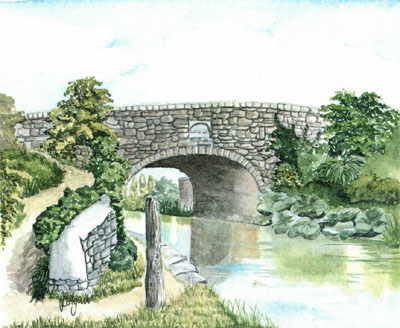 Louisa Bridge, painted by Janet Colgan
Louisa Bridge, painted by Janet Colgan
Simmonds was an attorney and practiced from Clare Street, Dublin. In 1804 he married a neighbour, Sarah Cooper, whose family had settled in Barnhall around 1756, and later lived at Easton House.
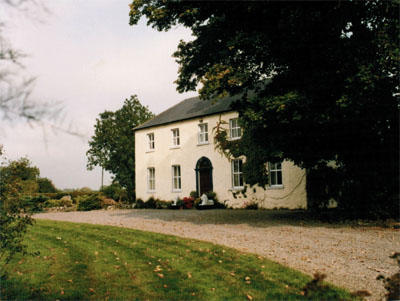 Easton House (1995)
Easton House (1995)
John Eston Simmonds (Easton House) and William Donnellan (Ravensdale House) were officers in the Leixlip volunteer cavalry at the time.
Many troops of one kind or another were billeted in the town, most likely in Leixlip Castle, which had accommodation of over double that of today. They were also billeted in the Black Castle on Mill Lane. Government troops billeted at Leixlip include those who featured in a defeat at Castlebar; the battle was known as the ‘Castlebar Races’. These troops wed local women, who had children by them. They were married by the Vicar, Edward Berwick, son of the 2nd Duke of Berwick; the first Duke fought for King James at the Battle of the Boyne. The parish register at St Mary’s Church records them:
Marriages
Arthur Williams, Private, Kilkenny Militia & Christiana Fowlkes of Leixlip, Spinster (5/2/1799). Joseph Hewen, Esq, Captain, Angus Fencibles & Eliza-Ann Guinness of Leixlip, Spinster (13/7/1799). Nathaniel Brady, Private, Londonderry Militia & Ann Magrath of Leixlip, Spinster (18/10/1799). John Downing Nesbit, Esq, of Tober Daly, Kings County, Captain, Londonderry Militia & Jane Brady of Leixlip, Spinster (16/1/1800). William Cowper, Private, Aberdeenshire Fencibles, & Martha Frazer of Leixlip, Spinster (1/3/1801). Henry Kerr, Musician, Aberdeenshire Fencibles & Mary Johnston, daughter of Sergt Johnston, 3d Regiment, Spinster (3/5/1801). William Dow, Private, Aberdeenshire Fencibles, & Frances White of Lucan, Spinster (25/10/1801). Thomas Barker, Private, Aberdeenshire Fencibles, & Catharine Brennan of Leixlip, Spinster (13/12/1801). John Hutchinson, Private, Aberdeenshire Fencibles, & Teresa Kelly of Leixlip, Spinster, (27/12/1801). Alexander Shanock, Private, Aberdeenshire Fencibles, & Sarah Downey of Leixlip, Spinster (17/1/1802). John Story, Private, Aberdeenshire Fencibles, & Frances Cassidy Leixlip, Spinster. Thomas Jump, Private, Aberdeen Fencibles, & Honora Mealy of Lucan, Spinster. (20/4/1802). William Owen, Esq, Lieutenant, 67th Regiment of Foot, & Matilda Guinness of Leixlip, Spinster (17/2/1803). Thomas Davis, Private, Antrim Militia, & Margaret Doherty of Leixlip, Spinster (8/2/1807). Robert Kinly, Private, Antrim Militia, & Margaret Martin, Leixlip, Spinster (29/3/1807). William Jones of Radnnshire Militia, Private, & Anne Corrigan of Leixlip, Spinster (22/11/1802). Henry Sullivan of Dublin County Militia to Eliza Ward of Leixlip (18/2/1818).
Deaths
On 6/10/1797, a Soldier. On 23/10/1797, a Soldier. On 30/11/1799, Sergeant Downing, Londonderry Militia, Leixlip. On 1/12/1799, Sergeant Pollock Londonderry Militia, Leixlip. On 28/5/1800, General William Brady. On 19/1/1814, Lieutenant O’Mally’s child. On 24/11/1820, Philip Lorance [sic], County Dublin Militia. On 26/1/1821, Sergeant Boyce, County Dublin Militia. On 9/12/1821, Captain Charles Baugh Hill. On 16/3/1823, Captain Hackett’s child [He lived in Music Hall.] Captain Burke died on the 1st and was buried on the 3d of July 1835.
Births or Baptisms
Lucy, dau of Capt Thomas & Eliza Woods, 12th Easter, 1782. Helen, dau of James Dougherty, artillery soldier, Leixlip, 7/9/1783. Eleanor, dau of James & Mary Dogherty, Leixlip, 3/6/1787. Letitia, dau of Prime Sergeant Fitzgerald, Lucan, 10/8/1788. John, son of Andrew Molloy, 47th Regt, Private, Lucan, 19/10/1788. Mary, dau of James & Mary Dogherty, Lucan, 15/8/1792. Anne Louisa, dau of Robert & Celia Mayne, soldier in Fermanagh Militia, born 3/12/1797. John, son of Andrew & Margaret Hamilton, private in the Fermanagh Militia, born Leixlip, 15/3/1798. James, son of Matthew & Bridget Johnston, private in the Fermanagh Militia, born 17/4/1798. Elizabeth, dau of William & Joanna Brimner, surgeon, Duke of York’s Highlanders, born 17/6/1798. Margaret, dau of Robert & Mary Sarsen, private, Kilkenny Militia, born 31/10/1798. James, son of James & Elizabeth Lewis, private, Kilkenny Militia, born 30/11/1798. Francis, son of Samuel & Sarah Townshend, Private, Londonderry Militia, born 7/4/1799. William, son of William & Eliza McAulay, Private, Londonderry Militia, born 11/4/1799. Samuel, son of William & Bridget Moffit, Private, Londonderry Militia, born 23/5/1799. Mary, dau of Dougall & Hannah Clarke, Private, Angus Fencibles, born 12/9/1799. Jane, dau of Walter & Margaret McFarland, Private, Londonderry Militia, born 17/9/1799. Elizabeth, dau of George & Margaret May, Private, Londonderry Militia, born 29/9/1799. Harriet, daughter of Major & Lady Colthurst Grey, 41st Regt, born 25/10/1799. Margaret, dau of Barnaby & Mary McAlpine, Private, Londonderry Militia, born 23/11/1799. Hugh, son of Hugh & Ann Harton, Corporal, Londonderry Militia, born 5/12/1799. Juliana, dau of Arthur & Christian Williams, Private Kilkenny Militia, born 7/12/1799. Catharine, dau of John & Jane Ferguson, Lieutenant, Angusshire Fencibles, born 21/1/1799. James, son of George & Elizabeth Dickson, Private Angusshire Fencibles, born 21/12/1799.
For more information on Sandford, Major General Robert, MP, of Leixlip; Dempsey, Yeoman Nicholas and Lord Edward FitzGerald; Fergusson family; Salmon Leap Inn; Leixlip Castle see John Colgan, Leixlip, County Kildare, Leixlip, 2005. Email: johncolgan at iol.ie




























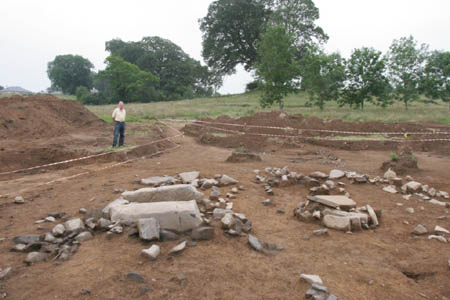
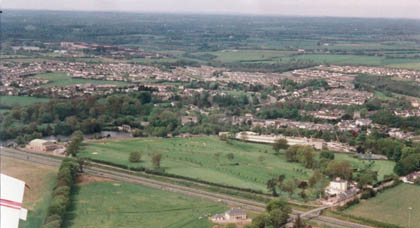
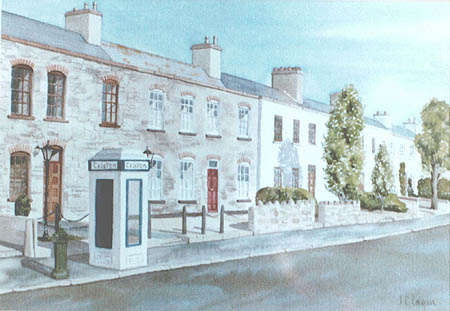
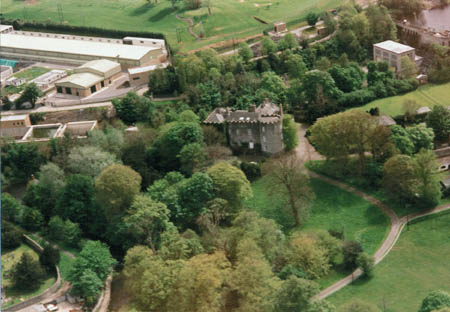 Aerial view of Leixlip Castle (~1200), with hydroelectric power station and water works in the background
Aerial view of Leixlip Castle (~1200), with hydroelectric power station and water works in the background